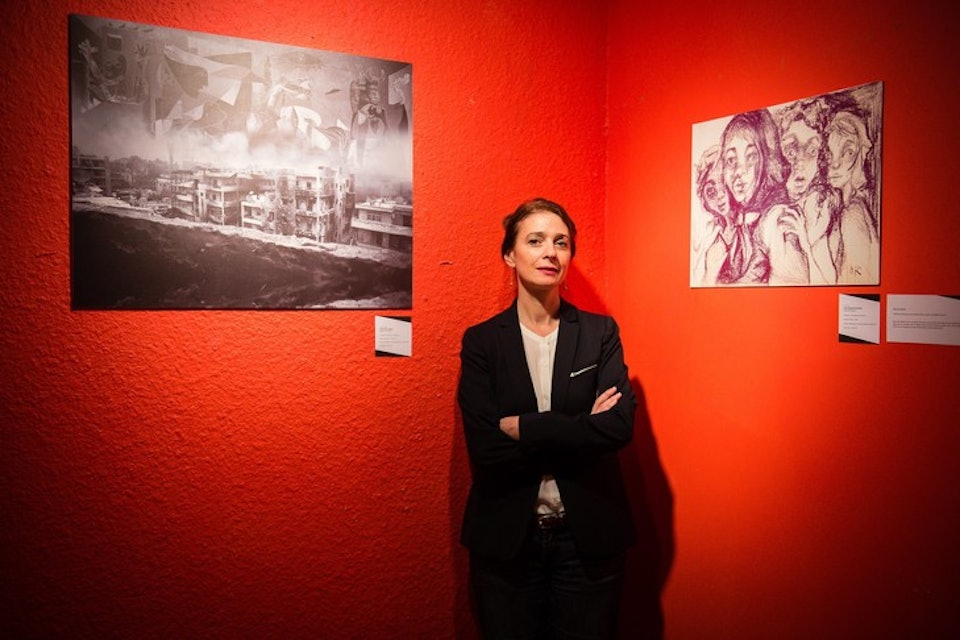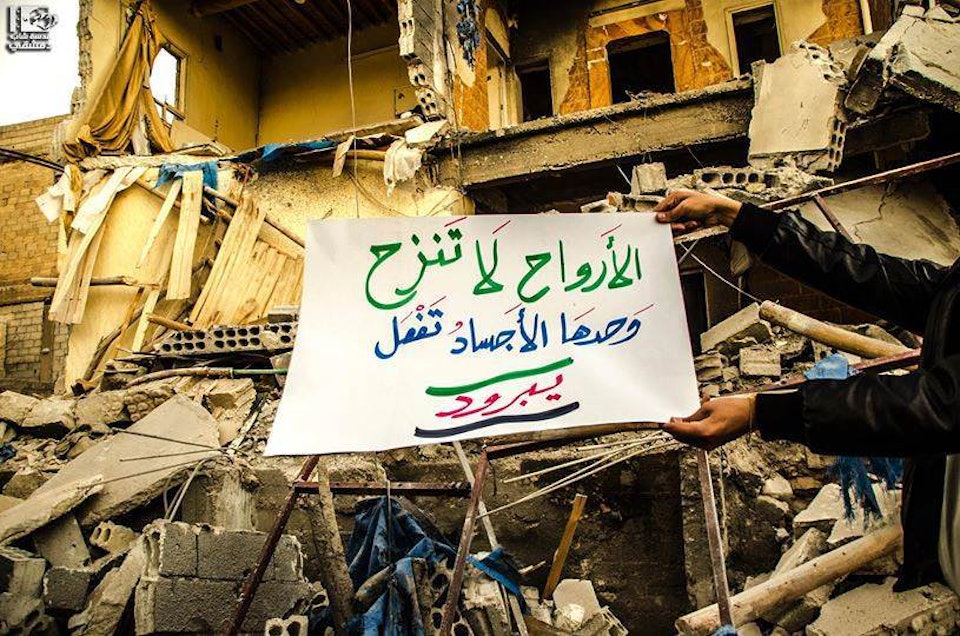Featured Organization
Creative Memory of the Syrian Revolution
Syria

In many ways, art was one of the catalysts of the Syrian Revolution. In March 2011, fifteen teenage boys from Dara’a, a rural city in southwestern Syria, painted anti-government murals and graffiti on their high school’s walls. Soon after, they were arrested and tortured, and a series of demonstrations erupted detesting this atrocity. As the protests mounted, security forces opened fire and several people died, triggering a nationwide uproar demanding the resignation of President Bashar al-Assad. “Dara’a is Syria,” hundreds of political dissidents chanted in Damascus later that month as escalating violence across the country revealed the gravity of economic disparity and social mistreatment under al-Assad’s regime. Now, Dara’a is often described as “the spark that lit Syria’s flame.”
Syria soon became engulfed in civil war. By August 2015, the United Nations reported that approximately 250,000 civilians had been killed, and around 12 million displaced. The Syrian Civil War has since become one of the bloodiest and most devastating armed conflicts in decades.

Just as artistic resistance played a significant role in the beginning of the revolution, it also came to be a preserving force for Syria’s cultural and historical memory, as the rippling effects of the civil war led to widespread destruction of culturally significant artifacts and spaces and provoked mass displacement. Witnessing the way art was both a generative force while it was simultaneously being lost, Syrian graphic designer Sana Yazigi decided to found Creative Memory of the Syrian Revolution, a project that aims to archive artistic and cultural expressions during the revolution and redefine art and activism in the context of the brutally repressive Syrian regime. “The artist is considered a citizen before anything else,” Yazigi wrote, “resisting with his/her art and standing by his/her people’s fight for freedom."
Seeing how the Syrian regime’s media, as well as a number of international outlets, villainized the sociopolitical unrest in her country, Yazigi envisioned a collection of the stories and experiences of the Syrian people’s struggle as captured through the art of their awakening. Prior to the revolution in Syria, many artists were marginalized and forced to turn to self-censorship or exile. The institutionalization of censorship and surveillance across Syria, as authorities monitored pro-democracy activists, forced many Syrians to disconnect from all forms of political, artistic, and creative expression. Yet, as Yazigi reveals, because the revolution transcended class and generational divides to mobilize all people, art became the collective voice of the movement.

When the revolution began, Yazigi was already running The Cultural Diary, a monthly print publication in Arabic and English that covered cultural life in Damascus. The Cultural Diary was started in 2007 and ran until 2012. After the revolution began, Yazigi realized the breadth and scope of creative responses necessitated more than a diary. Soon, its structure evolved to become Creative Memory, a digital archive of more than 11,500 original materials translated into both English and French from Arabic, including graffiti, murals, drawings, sculptures, videos, photos, poems, songs, caricatures, theatrical works, and texts produced during and in response to the revolution. Many of these do not exist as “documents” that can easily be archived, so much of the project’s core is actually turning the works that might not otherwise survive into archivable material. Over time, Yazigi’s team grew, and she credits her colleagues’ collective work for the project’s ongoing success and sustainability.
Through one of the projects, “Idlib Walls, ” named for the Syrian city, Creative Memory spotlights one of the most emblematic elements of the revolution: street art. Launched on December 8, 2018, this continuously-updated timeline features more than 540 street murals and graffiti pieces. Seeking to pay tribute to the lives lost in the Syrian people’s fight for democracy, Creative Memory sought to return to and memorialize graffiti, the “catalyst” of the revolution. This archive immortalizes the hope for peace and liberty and the struggle against violence, war, and oppression as captured on walls, alleyways, and buildings throughout the revolution.

Creative Memory’s second large-scale project, “The Map,” stands at the intersection of history, art, and geography to illustrate the development of the revolution through a visual “trip over Syria.” Containing countless documents from over 200 locations across Syria, this project assembles stories gleaned directly from Syrian people into a collective visualization of resistance during the revolution. “The Map” safeguards cultural heritage by not only enshrining and providing access to works of revolutionary art, but also linking these digital memories to their exact geographic origins.

In a society facing multiple forms of censorship and repression, primarily perpetrated by al-Assad’s regime over the last fifty years, but also by many “de facto powers” during the revolution and war, Creative Memory serves as an innovative platform for preserving creative works and Syrian cultural history, safeguarding cultural and historical wealth and returning it to the Syrian people while simultaneously facilitating access to information and heritage. In this way, it provides a palpable framework for the defense of human and cultural rights. Documenting cultural creativity and activism, especially in times of conflict, is essential both to memorializing that conflict and to ensuring the safety of creatives and artists. A bridge between those who fight for freedom of expression and those who use their freedom of expression to fight for a better world, Creative Memory epitomizes the defense of cultural rights for Syria and the rest of the world.
By Mabel Acosta and Sabrina Surgil, June 2020. Mabel is a recent graduate of the John Jay College of Criminal Justice. Sabrina is a rising senior at Vassar College majoring in History and French and Francophone Studies. She is involved with advocacy work in human rights and forced displacement on and off campus.